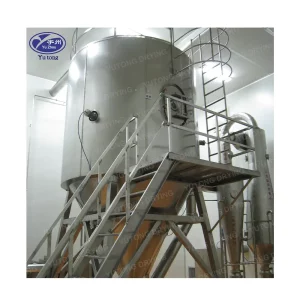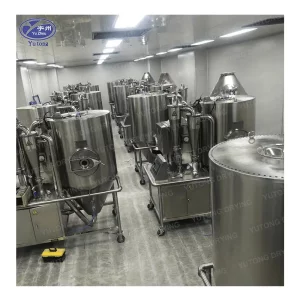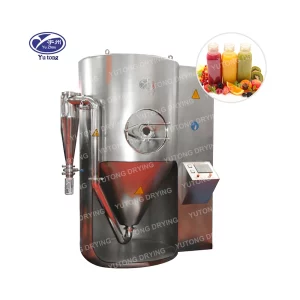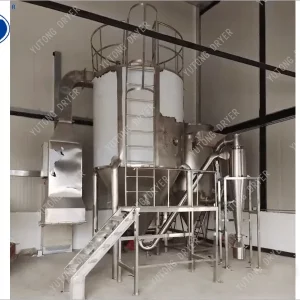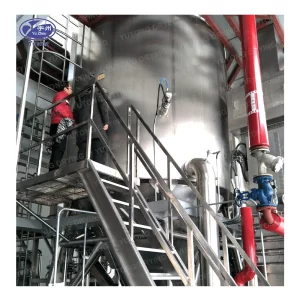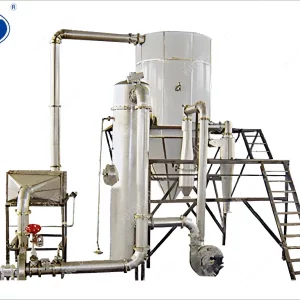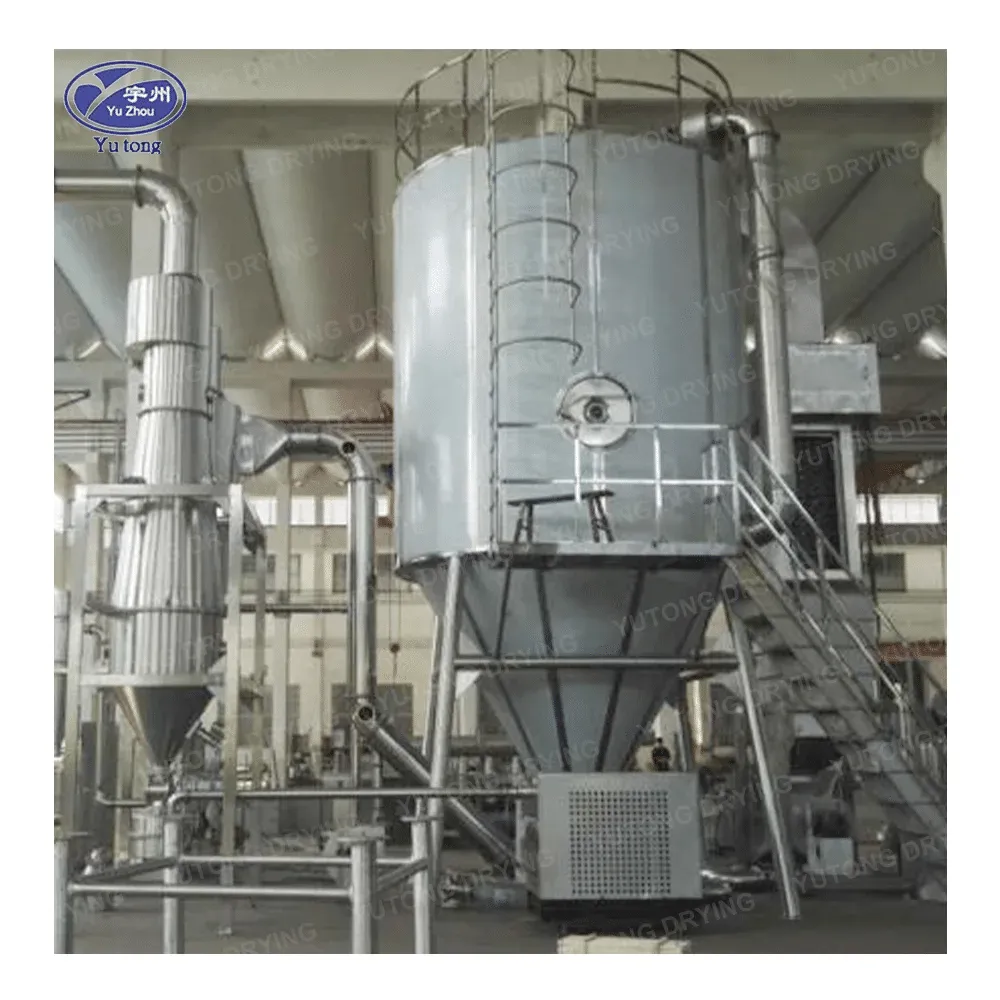In the world of industrial processing, spray drying is a crucial technique that offers a wide range of benefits for transforming liquid substances into dry powders. Understanding the essential principles of spray drying is essential for optimizing the process and achieving high-quality end products. In this article, we will explore the fundamental aspects of spray drying, including its working principle, key components, and factors that influence its performance.
Spray drying has become an integral part of many industries, such as food, pharmaceuticals, chemicals, and cosmetics. Its ability to produce powders with specific properties and characteristics makes it a valuable tool for manufacturers. By atomizing a liquid feed into fine droplets and exposing them to a hot gas stream, spray drying rapidly evaporates the moisture, leaving behind dry powder particles.
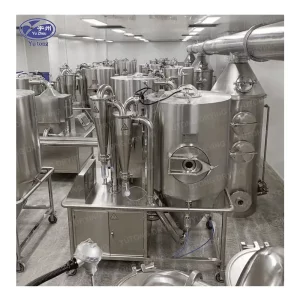
Working Principle of Spray Drying
The spray drying process is based on the principle of convective heat transfer. Liquid feed is atomized into tiny droplets, which are then suspended in a hot gas stream. The hot gas transfers heat to the droplets, causing the moisture to evaporate quickly. As the droplets dry, they shrink and solidify, forming dry powder particles.
The atomization step is crucial as it determines the size and distribution of the droplets. Different atomization methods, such as pressure nozzles, rotary atomizers, and two-fluid nozzles, are available, each with its own advantages and limitations. The choice of atomization method depends on factors such as the properties of the liquid feed, the desired powder properties, and the production capacity.
Once the droplets are atomized, they enter the drying chamber, where they are exposed to the hot gas stream. The drying chamber is designed to provide optimal conditions for heat transfer and moisture removal. It typically has a cylindrical or conical shape and is equipped with baffles or other flow control devices to ensure even distribution of the gas and droplets.
As the droplets dry, they move through the drying chamber and are separated from the gas stream by a powder separator. The separated powder is collected and can be further processed or packaged, while the gas stream, which is now laden with moisture, is usually exhausted through a filter or scrubber to remove any remaining particles before being released to the atmosphere.
Key Components of a Spray Drying System
1. Atomizer
The atomizer is the heart of the spray drying system. It is responsible for converting the liquid feed into fine droplets. As mentioned earlier, there are different types of atomizers available, each with its own characteristics.
Pressure nozzles use high-pressure liquid to create a fine spray. They are suitable for low-viscosity feeds and can produce droplets with a narrow size distribution. Rotary atomizers, on the other hand, use a spinning disk to atomize the liquid. They are capable of handling high-viscosity feeds and can produce large quantities of droplets. Two-fluid nozzles use a combination of a liquid and a gas to atomize the feed. They can produce very fine droplets and are often used for specialized applications.
The choice of atomizer depends on factors such as the viscosity and surface tension of the liquid feed, the desired droplet size distribution, the production capacity, and the cost.
2. Drying Chamber
The drying chamber is where the drying process takes place. It is designed to provide a controlled environment for heat transfer and moisture removal. The size and shape of the drying chamber depend on the production capacity and the characteristics of the powder being produced.
The drying chamber is typically insulated to minimize heat loss and is equipped with heaters or burners to provide the hot gas stream. The gas flow rate and temperature are carefully controlled to ensure optimal drying conditions.
Some drying chambers are also equipped with baffles or other flow control devices to ensure even distribution of the gas and droplets. This helps to improve the drying efficiency and the quality of the final powder.
3. Hot Gas Generator
The hot gas generator provides the heat source for the drying process. It can be a direct-fired burner, an indirect-heated air heater, or a combination of both. The choice of hot gas generator depends on factors such as the available fuel source, the required temperature and flow rate of the hot gas, and the environmental regulations.
The hot gas generator must be designed to provide a consistent supply of hot gas at the required temperature and flow rate. It should also be efficient and reliable, minimizing energy consumption and maintenance requirements.
4. Powder Separator
The powder separator is used to separate the dry powder particles from the gas stream. There are several types of powder separators available, including cyclone separators, bag filters, and electrostatic precipitators.
Cyclone separators are the most commonly used type of powder separator in spray drying systems. They work by using centrifugal force to separate the powder particles from the gas stream. Bag filters are also widely used, especially for fine powders. They use filter bags to trap the powder particles while allowing the gas to pass through. Electrostatic precipitators are used for very fine powders and can achieve high separation efficiencies.
The choice of powder separator depends on factors such as the particle size and density of the powder, the gas flow rate, and the required separation efficiency.
5. Control System
The control system is responsible for monitoring and controlling the various parameters of the spray drying process. It typically includes sensors, controllers, and actuators to measure and adjust the temperature, flow rate, pressure, and other parameters.
The control system must be able to maintain stable process conditions and ensure consistent product quality. It should also be able to respond quickly to changes in the process parameters and adjust the operation of the system accordingly.
Modern control systems often use programmable logic controllers (PLCs) or distributed control systems (DCS) to provide advanced control and monitoring capabilities.
Factors Affecting Spray Drying Performance
1. Liquid Feed Properties
The properties of the liquid feed have a significant impact on the spray drying process. These properties include viscosity, surface tension, solid content, chemical composition, and heat sensitivity.
High-viscosity feeds may require special atomization techniques or heating to ensure proper atomization and drying. Surface tension can affect the droplet size and shape, while solid content can affect the drying time and powder properties.
The chemical composition of the liquid feed can also affect its drying behavior and the stability of the powder. For example, some materials may be heat-sensitive and require lower drying temperatures to prevent degradation.
Understanding the properties of the liquid feed is essential for selecting the appropriate atomizer, drying conditions, and powder separator.
2. Atomization Parameters
The atomization parameters, such as nozzle type, atomization pressure, and feed rate, can have a significant impact on the droplet size distribution and drying efficiency.
Smaller droplets dry more quickly but may be more susceptible to agglomeration. Larger droplets may require longer drying times but can result in powders with better flow properties.
The atomization pressure and feed rate must be optimized to ensure consistent droplet size and drying performance. Too high or too low atomization pressure can lead to uneven droplet size distribution and poor drying efficiency.
The choice of atomizer and the adjustment of atomization parameters depend on the properties of the liquid feed and the desired powder properties.
3. Drying Conditions
The drying conditions, such as inlet gas temperature, outlet gas temperature, and gas flow rate, can affect the drying time, powder properties, and energy consumption.
Higher inlet gas temperatures can result in faster drying times but may also cause thermal degradation of heat-sensitive materials. Lower inlet gas temperatures may require longer drying times but can be more suitable for heat-sensitive materials.
The outlet gas temperature must be controlled to ensure that the powder is fully dried and that the moisture content is within the desired range. The gas flow rate must be optimized to provide sufficient heat transfer and moisture removal while minimizing energy consumption.
The drying conditions must be carefully selected and controlled to achieve the desired powder properties while minimizing energy consumption and production costs.
4. Powder Separation Efficiency
The efficiency of the powder separator can affect the quality and yield of the powder. A poor powder separator may result in losses of fine powder or contamination of the gas stream with powder particles.
The powder separator must be properly sized and operated to ensure efficient separation and clean gas emissions. Factors such as the particle size and density of the powder, the gas flow rate, and the separation mechanism can affect the separation efficiency.
Regular maintenance and cleaning of the powder separator are essential to ensure consistent performance and prevent clogging or contamination.
Applications of Spray Drying
1. Food Industry
Spray drying is widely used in the food industry to produce powdered ingredients such as milk powder, coffee creamer, instant soups, and flavorings. The ability to produce powders with good solubility, flowability, and stability makes spray drying an ideal method for food processing.
Additionally, spray drying can be used to encapsulate flavors, vitamins, and other sensitive ingredients to protect them from degradation and improve their stability. This is particularly important in the production of functional foods and nutraceuticals.
Spray-dried food products often have a longer shelf life than their liquid counterparts, making them more convenient for storage and transportation.
2. Pharmaceuticals
In the pharmaceutical industry, spray drying is used to produce powders for inhalation drugs, tablets, capsules, and other dosage forms. The ability to control the particle size and morphology of the powder is crucial for ensuring proper drug delivery and efficacy.
Spray drying can also be used to dry biological materials such as vaccines and proteins, preserving their activity and stability. This is important for the development and production of biopharmaceuticals.
The controlled release properties of spray-dried powders can be exploited to design drug delivery systems that release the active ingredient over a specific period of time.
3. Chemicals
Spray drying is used in the chemical industry to produce powders of pigments, dyes, catalysts, and other chemicals. The high drying efficiency and ability to handle different types of liquid feeds make it a suitable method for chemical processing.
Additionally, spray drying can be used to produce nanomaterials and other advanced materials with specific properties. For example, spray drying can be used to produce nanoparticles with controlled size and shape for applications in catalysis, electronics, and medicine.
The purity and homogeneity of the powder produced by spray drying are important for chemical applications, as they can affect the performance and quality of the final product.
4. Cosmetics
In the cosmetics industry, spray drying is used to produce powders for makeup, skincare products, and hair care products. The ability to produce powders with fine particle sizes and good flowability makes spray drying an ideal method for cosmetic processing.
Spray drying can also be used to encapsulate active ingredients such as vitamins, antioxidants, and sunscreen agents to improve their stability and efficacy. This is particularly important in the production of natural and organic cosmetics.
Spray-dried cosmetic products often have a more luxurious feel and better application properties than their liquid counterparts.
Spray drying is a complex yet highly effective technique for transforming liquid materials into dry powders. Understanding the essential principles of spray drying, including its working principle, key components, and factors affecting performance, is crucial for optimizing the process and achieving high-quality end products. By carefully considering the properties of the liquid feed, atomization parameters, drying conditions, and powder separation efficiency, manufacturers can design and operate spray drying systems that meet their specific needs and requirements. With its wide range of applications and potential for innovation, spray drying is likely to continue playing an important role in various industrial sectors.

